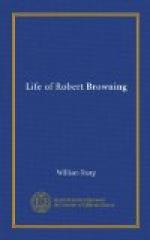Remarkable as are the three last-named productions, it is extremely doubtful if the first and second will be read for pleasure by readers born after the close of this century. As it is impossible, in my narrow limits, to go into any detail about poems which personally I do not regard as essential to the truest understanding of Browning, the truest because on the highest level, that of poetry—as distinct from dogma, or intellectual suasion of any kind that might, for all its aesthetic charm, be in prose—it would be presumptuous to assert anything derogatory of them without attempting adequate substantiation. I can, therefore, merely state my own opinion. To reiterate, it is that, for different reasons, these three long poems are foredoomed to oblivion—not, of course, to be lost to the student of our literature and of our age, a more wonderful one even than that of the Renaissance, but to lapse from the general regard. That each will for a long time find appreciative readers is certain. They have a fascination for alert minds, and they have not infrequent ramifications which are worth pursuing for the glimpses afforded into an always evanishing Promised Land. “Prince Hohenstiel-Schwangau” (the name, by the way, is not purely fanciful, being formed from Hohen Schwangau, one of the castles of the late King of Bavaria) is Browning’s complement to his wife’s “Ode to Napoleon III.” “Red Cotton Nightcap Country” is a true story, the narrative of the circumstances pertinent to the tragic death of one Antonio Mellerio, a Paris jeweller, which occurred in 1870 at St. Aubin in Normandy, where, indeed, the poet first heard of it in all its details. It is a story which, if the method of poetry and the method of prose could for a moment be accepted as equivalent, might be said to be of the school of a light and humorously grotesque Zola. It has the fundamental weakness of “The Ring and the Book”—the weakness of an inadequate ethical basis. It is, indeed, to that great work what a second-rate novelette is to a masterpiece of fiction.
“Fifine at the Fair,” on the other hand, is so powerful and often so beautiful a poem that one would be rash indeed were he, with the blithe critical assurance which is so generally snuffed out like a useless candle by a later generation, to prognosticate its inevitable seclusion from the high place it at present occupies in the estimate of the poet’s most uncompromising admirers. But surely equally rash is the assertion that it will be the “poem of the future.” However, our concern is not with problematical estimates, but with the poem as it appears to us. It is one of the most characteristic of Browning’s productions. It would be impossible for the most indolent reader or critic to attribute it, even if anonymous, to another parentage. Coleridge alludes somewhere to certain verses of Wordsworth’s, with the declaration that if he had met them howling in the desert he would have recognised their authorship. “Fifine” would not even have to howl.




